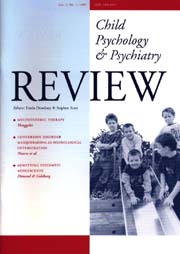Crossref Citations
This article has been cited by the following publications. This list is generated based on data provided by
Crossref.
Alvarez, Anne
Reid, Susan
and
Hodges, Sally
1999.
Autism and play - the work of the Tavistock autism workshop.
Child Language Teaching and Therapy,
Vol. 15,
Issue. 1,
p.
53.
Jenvey, Vickii B.
and
Jenvey, Heidi L.
2002.
CRITERIA USED TO CATEGORIZE CHILDREN'S PLAY: PRELIMINARY FINDINGS.
Social Behavior and Personality: an international journal,
Vol. 30,
Issue. 8,
p.
733.
Ginsburg, Kenneth R.
2007.
The Importance of Play in Promoting Healthy Child Development and Maintaining Strong Parent-Child Bonds.
Pediatrics,
Vol. 119,
Issue. 1,
p.
182.
Case-Smith, Jane
and
Kuhaneck, Heather Miller
2008.
Play Preferences of Typically Developing Children and Children with Developmental Delays between Ages 3 and 7 Years.
OTJR: Occupation, Participation and Health,
Vol. 28,
Issue. 1,
p.
19.
Lordelo, Eulina da Rocha
and
Bichara, Ilka Dias
2009.
Revisitando as funções da imaturidade: uma reflexão sobre a relevância do conceito na Educação Infantil.
Psicologia USP,
Vol. 20,
Issue. 3,
p.
337.
Fiaes, Carla Silva
and
Bichara, Ilka Dias
2009.
Brincadeiras de faz-de-conta em crianças autistas: limites e possibilidades numa perspectiva evolucionista.
Estudos de Psicologia (Natal),
Vol. 14,
Issue. 3,
p.
231.
Drewes, Athena A.
2009.
Evidence‐Based Practice in Infant and Early Childhood Psychology.
p.
289.
Borg, Suzanne
2009.
ADHD and problem-solving in play.
Emotional and Behavioural Difficulties,
Vol. 14,
Issue. 4,
p.
325.
Santos, Ana Karina
and
Dias, Álvaro Machado
2010.
Comportamentos lúdicos entre crianças do nordeste do Brasil: categorização de brincadeiras.
Psicologia: Teoria e Pesquisa,
Vol. 26,
Issue. 4,
p.
585.
Barbu, Stéphanie
Cabanes, Guénaël
Le Maner-Idrissi, Gaïd
and
Semple, Malcolm
2011.
Boys and Girls on the Playground: Sex Differences in Social Development Are Not Stable across Early Childhood.
PLoS ONE,
Vol. 6,
Issue. 1,
p.
e16407.
Chard, Gill
and
Pierse, Aislinn
2011.
The Effect of Introducing Nonplay Items into a Primary School Playground in Ireland.
Journal of Occupational Therapy, Schools, & Early Intervention,
Vol. 4,
Issue. 3-4,
p.
291.
Marques, Reginalice de Lima
and
Bichara, Ilka Dias
2011.
Em cada lugar um brincar: reflexão evolucionista sobre universalidade e diversidade.
Estudos de Psicologia (Campinas),
Vol. 28,
Issue. 3,
p.
381.
Beran, Tanya N.
Ramirez-Serrano, Alejandro
Kuzyk, Roman
Fior, Meghann
and
Nugent, Sarah
2011.
Understanding how children understand robots: Perceived animism in child–robot interaction.
International Journal of Human-Computer Studies,
Vol. 69,
Issue. 7-8,
p.
539.
Erickson, Sarah J.
Montague, Erica Q.
Maclean, Peggy C.
Bancroft, Mary E.
and
Lowe, Jean R.
2012.
Differential ethnic associations between maternal flexibility and play sophistication in toddlers born very low birth weight.
Infant Behavior and Development,
Vol. 35,
Issue. 4,
p.
860.
Kendrick, April
Hernandez-Reif, Maria
Hudson, Carmen
Jeon, Hyun-Joo
and
Horton, Charlotte
2012.
Coding group behaviours for preschool children in the playground and the effects of teachers’ proximity on preschool children’s playground behaviours.
Early Child Development and Care,
Vol. 182,
Issue. 6,
p.
665.
Naelys Diaz
Patricia Liehr
Laurie Curnan
Jaime-Lee A. Brown
and
Kathy Wall
2012.
Playing Games: Listening to the Voices of Children to Tailor a Mindfulness Intervention.
Children, Youth and Environments,
Vol. 22,
Issue. 2,
p.
273.
Staples, Kerri L.
MacDonald, Megan
and
Zimmer, Chantelle
2012.
International Review of Research in Developmental Disabilities Volume 42.
Vol. 42,
Issue. ,
p.
179.
Milteer, Regina M.
Ginsburg, Kenneth R.
Mulligan, Deborah Ann
Ameenuddin, Nusheen
Brown, Ari
Christakis, Dimitri A.
Cross, Corinn
Falik, Holly Lee
Hill, David L.
Hogan, Marjorie J.
Levine, Alanna Estin
O’Keeffe, Gwenn S.
and
Swanson, Wendy Sue
2012.
The Importance of Play in Promoting Healthy Child Development and Maintaining Strong Parent-Child Bond: Focus on Children in Poverty.
Pediatrics,
Vol. 129,
Issue. 1,
p.
e204.
Gaino, Silvana B.
Assumpção Jr., Francisco Baptista
Neto, Gerson Silva Santos
and
Galvao, Victor
2013.
Construction and Validation of the Gender Apperception Test-GAT for Children.
Psychology,
Vol. 04,
Issue. 11,
p.
891.
Coyl-Shepherd, Diana D.
and
Hanlon, Colleen
2013.
Family play and leisure activities: correlates of parents' and children's socio-emotional well-being.
International Journal of Play,
Vol. 2,
Issue. 3,
p.
254.




